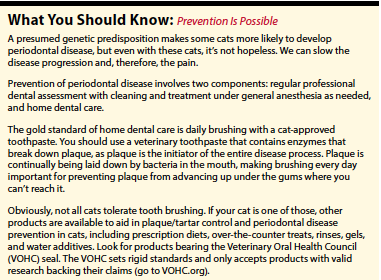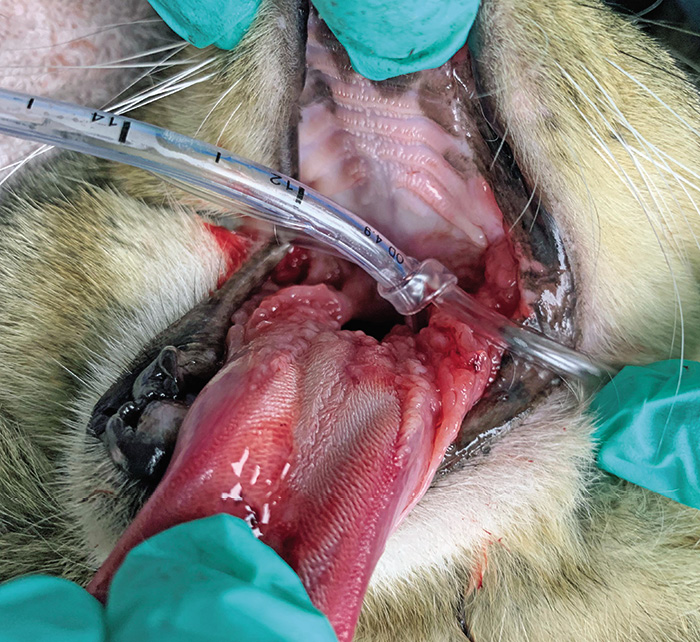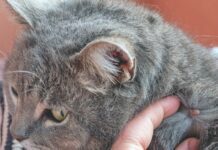Periodontal disease is common in small animals, but cats take it a step further, being prone to two unique and painful oral disorders: tooth resorption (TR) and chronic gingivostomatitis (CGS).
“Periodontal disease and tooth resorption are the most common reasons cats are seen by the dentistry service here at Cornell’s Companion Animal Hospital,” says Nadine Fiani, BVSc, section chief of veterinary dentistry and oral surgery at Cornell University’s College of Veterinary Medicine. “These are conditions generally managed well by primary care veterinarians. As such, the cases we see at Cornell are often elderly cats with comorbidities (other illnesses), making their care a bit more complicated.”
Periodontal disease, which is a set of inflammatory conditions affecting the tissues surrounding the teeth, starts with plaque. Plaque is an invisible slime laid down by bacteria on the surface of the tooth above and below the gum line. Plaque, in addition to eventually promoting the formation of visible tartar, causes inflammation of the gums (gingivitis), creates deep pockets between the tooth and gum (periodontal pockets), and damages the supporting structures of the tooth roots (periodontitis). The result is tooth loss, pain, and an open door for infection.
If your cat suffers from periodontal disease, you’ll likely initially notice bad breath. As the disease advances, you may notice pawing at the mouth, bloody drool, changes in eating habits, taking longer to eat, and withdrawal/hiding.
Tooth Resorption
Tooth resorption usually starts in the enamel (outside of the tooth) and progresses deeper into the tooth and its root. It’s fair to think of it as a cavity starting on the outside of the tooth, exposing the sensitive deeper layers of the tooth. It’s a chronic, painful condition that ultimately results in complete destruction of the tooth and root. Because it is so painful, surgical extraction of affected teeth is recommended as soon as it is identified.
While dogs occasionally suffer from resorptive lesions, tooth resorption is pretty much a cat disease. “Approximately 50% of cats will develop tooth resorption in their lifetime,” says Dr. Fiani. “Tooth resorption in cats is a very annoying mystery. We still don’t know what causes it.”
For now, your best course is to follow your veterinarian’s advice and have regular professional dental assessments and dental x-rays, including cleaning and treatments under general anesthesia. This allows for early identification of resorptive lesions with surgical extraction of affected teeth, helping ensure your cat isn’t silently suffering from this painful disorder.

Gingivostomatitis
Fortunately, chronic gingivostomatitis (CGS) is not as common as tooth resorption in cats. It is a debilitating, horrible disease unique to cats. It is excruciatingly painful. It is so painful that affected cats can develop malnutrition and serious secondary health problems because it hurts too much to eat.
Some experts think certain infectious agents like feline calicivirus, feline herpes virus, or Bartonella may be involved. Cats with feline immunodeficiency virus (FIV) are over-represented in the affected population, but a causative relationship between infection with these viruses and bacteria and CGS has not been scientifically proven.
“These cases are challenging and can be quite frustrating,” says Dr. Fiani. “This is mostly due to our incomplete understanding of the disease.”
We do know there is an immune component to the disease. Some veterinarians equate it to the cat basically being allergic to plaque and/or its own periodontal tissues. This is the reason treatment typically starts with surgical extraction of the teeth. If the inflammation is limited to the back part of the mouth, some cats can keep their canine and incisor teeth, with just the cheek teeth (molars and premolars) extracted. If this first step does not resolve the problem, however, the next step is to extract all remaining teeth in a second procedure.
For some cats, tooth extraction alone will be curative. If it’s not, immune-suppressive therapy is indicated. For those who are improved but not cured with these treatments, life-long pain management becomes necessary. Hypoallergenic diets have been tried. Stem-cell therapy is being studied as a possible treatment. If your cat suffers from this disease, you’ll likely try anything if there’s a chance it will make your cat more comfortable.
Even though full-mouth tooth extraction may seem aggressive, it’s the most important step in managing this devastating disease. Your cat can easily eat without teeth, and there are plenty of fat and happy “gummers” out there, with mouths that are now way more comfortable and functional than they’d be with teeth if they suffer from CGS.




